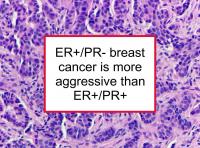A new review has been published that summarizes current knowledge concerning estrogen receptor positive/progesterone receptor negative (ER+/PR-) breast cancer. ER+/PR- tumors are a distinct subset of breast cancer known to have aggressive behavior and tamoxifen resistance despite being ER+.
They are categorized as luminal B tumors (estrogen receptor positive, often with low tumor grade, but with higher proliferation than other estrogen receptor positive tumors), with greater DNA instability than ER+/PR+ tumors.
High growth factor signaling contributes to the aggressive behavior of this type of breast cancer. The absence of PR is attributable to low circulating estrogen, low levels of nuclear ER, as well as variables pertaining to growth factors. ER+/PR- patients tend to have greater expression of human epidermal growth factor receptor (HER1 and HER2) and active growth factor signaling.
Currently, aromatase inhibitors, fulvestrant (Faslodex), and chemotherapy are the most common treatment approaches for ER+/PR- breast cancer patients. Overcoming tamoxifen resistance with targeted therapies such as gefitinib (Iressa), an epidermal growth factor receptor (EGFR) inhibitor, are being tried. Strategies involving short courses of tamoxifen have also been proposed to prevent recurrence of ER+/PR- breast cancer.
Study conclusions
The authors conclude that understanding the interplay between molecular endocrinology and tumor biology has provided experimental therapeutic insights, and continued work in this area holds the promise of future advances in prognosis.
Please see our article on breast cancer diet for ER+/PR- patients and survivors for more information.
